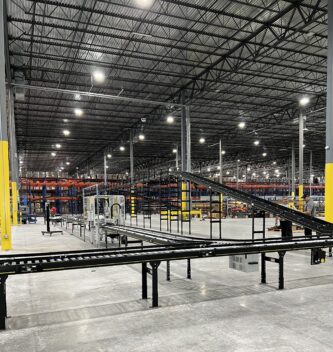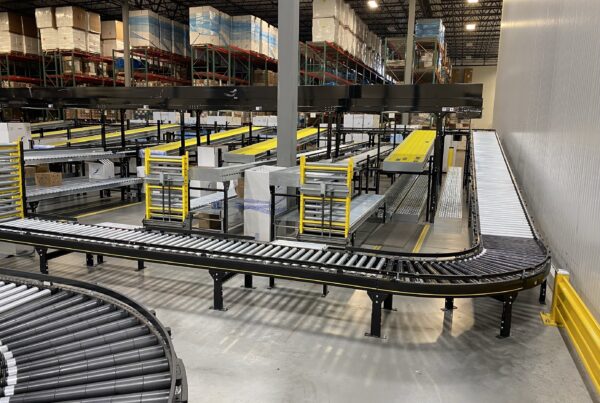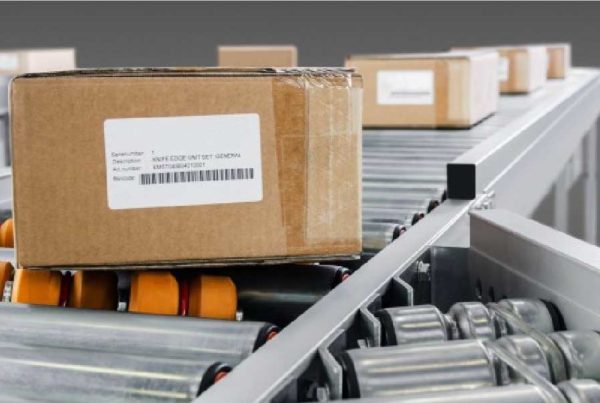Conveyor systems can be integral to many solutions from manufacturing to logistics. The power it takes to run these conveyor systems can have a growing impact on an operations overuse of energy. At the same time, conveyors can reduce operations carbon footprint. This article will explore how energy-efficient conveyor systems, sustainable practices in their design and operation, and real-world case studies can help reduce their carbon footprint.

Manufacturers are increasingly prioritizing sustainability, as recent findings from the Manufacturing Leadership Council’s annual survey show. In 2022, 58% of manufacturing executives viewed sustainability as crucial for future competitiveness, up from 38% in 2021 (MLC). As a result, energy efficiency has become one of the primary focuses. This makes the design and implementation of energy-efficient conveyor systems essential, not only for operational efficiency but also for achieving broader sustainability targets. Conveyor systems have reduced carbon emissions in several ways, including lowering diesel fuels, using renewable energy like solar and wind, using recyclable or biodegradable materials, and regulating proper maintenance (ERIKS).
Steps to finding Energy-Efficient Conveyor Systems
Here are key strategies for installing or updating your conveyor system with energy efficiency in mind (ASMECH).
- Motor Selection
Motors should operate at peak capacity when first turned on; from there the speed of the motor drops its range to a normal speed. The Rollerdrive Series EC5000 can be a viable energy-efficient option. This series has brushless drives that feature an energy-saving recovery option when braking. The EC5000’s system operates without pneumatic or conventional drives bringing continual, efficient running for any operation. For varying load weights, two-speed motors and adjustable drives are ideal as they enable motors to reach top capacity without overloading. Incorrect motor specifications can lead to increased breakages due to the added stress on the conveyor.
- Reduce Energy Cost with Run on Demand Conveyors
Some motor drive roller conveyors are automated, ethernet-connected systems that feature run-on-demand zones. These zones are especially helpful when reducing energy consumption, overall noise levels, operational maintenance, and life expectancy. When installing new motors or replacing old ones, opt for high-energy efficiency models. These can offer up to 8% additional energy efficiency over standard motors, making a significant difference in overall energy consumption (POWER).
- Embrace the Flexibility of Modular Conveyors
Modular conveyors provide versatility and adaptability for changing warehouse layouts. Their design allows for components to be reused and reconfigured, thereby extending the system’s lifespan and enhancing sustainability.
- Ensure Chain Durability
Choosing the right conveyor chain involves considering belt speeds, impact, and application temperatures to ensure durability. Modular plastic chains are particularly advantageous as worn sections can be easily replaced, minimizing downtime and maintenance costs.
- Implement a Thorough Maintenance Plan
Regular maintenance is essential to keep conveyor systems running efficiently. This includes checking and re-lubricating reducers and bearings, removing material buildup, and inspecting chains and components. Promptly replacing worn or damaged items and testing electrical components helps extend their lifecycle and minimize production disruptions.
- Design with Energy Savings in Mind
Energy savings can be maximized by selecting energy-efficient motors, powering down conveyors when not in use, and optimizing the layout to reduce friction. Using gravity chutes and straight-running conveyors can also lower energy usage. Additionally, collecting and analyzing energy consumption data can identify areas for further savings.
By implementing these strategies, warehouses can significantly enhance the energy efficiency of their conveyor systems, contributing to both operational efficiency and broader sustainability goals.
In today’s business climate, sustainability and energy use are at the forefront of operational considerations. For warehouses, which often have high production rates, increasing efficiency directly contributes to greater sustainability. Central to these facilities is the conveyor system.
In an age where energy efficiency is paramount, optimizing conveyor systems is essential for sustainable warehouse operations. By carefully selecting motors, utilizing modular designs, ensuring chain durability, adhering to preventive maintenance, and designing with energy savings in mind, businesses can significantly reduce their carbon footprint. These steps not only improve operational efficiency but also align with broader sustainability goals. Investing in energy-efficient conveyor systems is a crucial move towards a more sustainable future.
Contact SRSI today to learn more about our conveyor options!
https://www.srsi.com/conveyor-systems/
+1 833 – 228 – 6902 // [email protected]
 Skip to main content
Skip to main content







